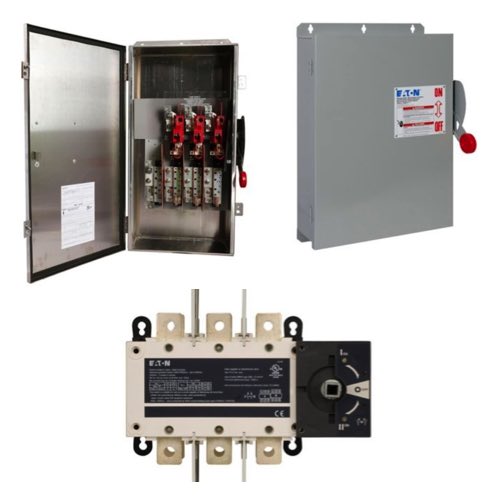Eaton Disconnects

RSP Supply carries a full line of Eaton disconnects, including heavy-duty and general-duty safety switches built for dependable power management and circuit protection. Eaton safety switches are designed to provide a secure means of isolating electrical power, ensuring that maintenance and emergency shutdowns can be performed safely and efficiently.
Eaton’s disconnects are available in two main categories, general-duty and heavy-duty, each engineered to meet specific application requirements. General-duty switches are ideal for light commercial or residential use, providing a reliable disconnect means in dry or indoor environments. Heavy-duty switches, by contrast, are intended for harsh industrial conditions where exposure to dust, moisture, or outdoor weather is common. Constructed from high-quality materials such as galvanized or painted steel, Eaton heavy-duty switches offer superior corrosion resistance and strength. Rated up to NEMA 3R, they are suitable for outdoor service entrance and distribution applications. Many models are available in fusible and non-fusible versions, giving users flexibility between built-in overcurrent protection and standard isolation functions.
Eaton also provides double-throw safety switches designed to transfer power between normal and emergency sources, ideal for critical systems such as elevator controls, data centers, or backup generator setups. These configurations are available for three-wire and three-pole installations, supporting a broad range of electrical layouts.
Each disconnect enclosure is designed for ease of use, durability, and safety compliance, exceeding the requirements set by the National Electrical Code (NEC) and other relevant standards. Whether used for service entrances, power distribution panels, or industrial machinery, Eaton disconnects ensure long-term reliability and protection.
FAQs
Q: What’s the difference between fusible and non-fusible safety switches?
Fusible safety switches include fuses that provide overcurrent protection, disconnecting power during overloads or short circuits. Non-fusible switches isolate circuits without integrated fuses, relying on external protective devices instead.
Q: What are fusible and non-fusible shunt trip safety switches used for?
These switches allow remote tripping to disconnect power during emergencies or maintenance. Fusible models add overcurrent protection, while non-fusible models depend solely on the shunt trip mechanism.
Q: Can double-throw safety switches be used in elevator control applications?
Yes. Double-throw safety switches are suitable for service entrance elevator control, allowing seamless transfer between main and emergency power sources.
Q: Do Eaton heavy-duty disconnects come in painted galvanized steel?
Yes. Eaton’s heavy-duty, single-throw disconnects are available in painted galvanized steel, offering superior durability and corrosion protection for demanding installations.
Q: Are Eaton disconnects suitable for outdoor use?
Many Eaton disconnect models are NEMA 3R rated, making them suitable for outdoor environments where protection from rain, sleet, and external elements is essential.
Why Buy Eaton Disconnects from RSP Supply
RSP Supply provides a complete selection of Eaton disconnects and safety switches backed by expert support, fast shipping, and competitive pricing. Whether you need a rugged heavy-duty switch for industrial environments or a general-duty unit for light commercial use, RSP Supply ensures you get reliable, compliant products designed for long-term electrical safety.

